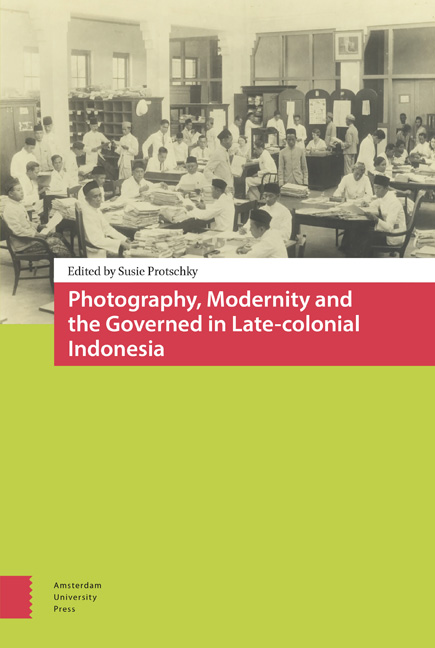Book contents
- Frontmatter
- Contents
- Acknowledgments
- Part I Governing Lenses on Ethical Policy and Practice
- 1 Camera Ethica: Photography, modernity and the governed in late-colonial Indonesia
- 2 Ethical policies in moving pictures: The films of J.C. Lamster
- 3 Ethical projects, ethnographic orders and colonial notions of modernity in Dutch Borneo: G.L. Tichelman's Queen's Birthday photographs from the late 1920s
- 4 Saving the children?: The Ethical Policy and photographs of colonial atrocity during the Aceh War
- Part II Local Lenses on Living in an “Ethical” Indies
- 5 Interracial unions and the Ethical Policy: The representation of the everyday in Indo-European family photo albums
- 6 Reversing the lens: Kartini's image of a modernised Java
- 7 Modelling modernity: Ethnic Chinese photography in the ethical era
- 8 Modernity and middle classes in the Netherlands Indies: Cultivating cultural citizenship
- 9 Say “cheese”: Images of captivity in Boven Digoel (1927-43)
4 - Saving the children?: The Ethical Policy and photographs of colonial atrocity during the Aceh War
Published online by Cambridge University Press: 11 December 2020
- Frontmatter
- Contents
- Acknowledgments
- Part I Governing Lenses on Ethical Policy and Practice
- 1 Camera Ethica: Photography, modernity and the governed in late-colonial Indonesia
- 2 Ethical policies in moving pictures: The films of J.C. Lamster
- 3 Ethical projects, ethnographic orders and colonial notions of modernity in Dutch Borneo: G.L. Tichelman's Queen's Birthday photographs from the late 1920s
- 4 Saving the children?: The Ethical Policy and photographs of colonial atrocity during the Aceh War
- Part II Local Lenses on Living in an “Ethical” Indies
- 5 Interracial unions and the Ethical Policy: The representation of the everyday in Indo-European family photo albums
- 6 Reversing the lens: Kartini's image of a modernised Java
- 7 Modelling modernity: Ethnic Chinese photography in the ethical era
- 8 Modernity and middle classes in the Netherlands Indies: Cultivating cultural citizenship
- 9 Say “cheese”: Images of captivity in Boven Digoel (1927-43)
Summary
Introduction
In the spring of 1904, less than three years after Queen Wilhelmina's famous exhortation that the Dutch should answer a moral calling with respect to the peoples of the Netherlands Indies, the Dutch colonial army made eight photographs depicting the mass deaths that resulted from its assaults on a number of fortified villages on the island of Sumatra. One of the most arresting aspects of these photographs is a number of surviving infants that sit between the dead bodies of their family members and neighbours, while above and around them soldiers are posing for the photographer.
I argue in this chapter that the meaning of these photographs within contemporary Dutch (colonial) society was far from clear. I will first discuss these photographs and some of the conflicting and confused responses to the expedition during which they were taken. Next, I will place these images in the context of European visual culture, both in Europe and in the Indies, specifically focusing on imagery of children. Finally, I will show that the ambiguous reception of these images was partly due to a tension in European ideas about the nature of the (native) child and its relation to the (colonial) state.
The photographs
Figures 1 and 2 depict two of the eight photographs of atrocity that were taken during the expedition. It is in these two images that children are most visible. The first was made on 14 June 1904 in the village of Koetö Réh, as it was then called by the Dutch, or Kuta Rih, as it is called in Indonesia today. The second photograph was made in the village of Koetö Lengat Baroe (Kutalengat Baru) on 24 June 1904. Both villages were located on the island of Sumatra, in the Alas land, then part of the colonial administrative district of Aceh and its dependencies. The photographer was a man called H.M. Neeb (1870-1933), a medical officer of the Dutch colonial army who took 173 photographs during a military expedition to the Gajo and Alas lands as part of the last phase of the Aceh War (1873-1914). The elite troops (marechaussees, or gendarmes) of the Royal Netherlands East Indies Army (Koninklijk Nederlandsch-Indisch Leger, or KNIL) marched from 8 February to 23 July, their main goal being the establishment of Dutch colonial authority in these regions.
- Type
- Chapter
- Information
- Publisher: Amsterdam University PressPrint publication year: 2015



